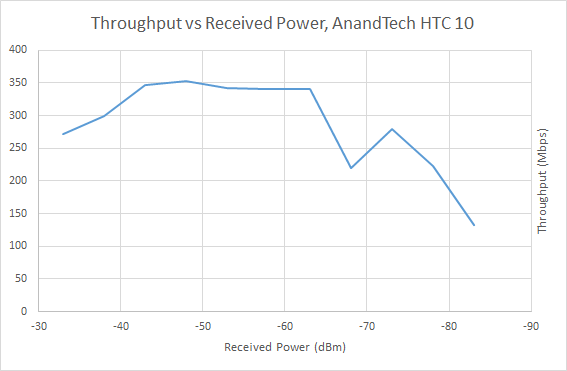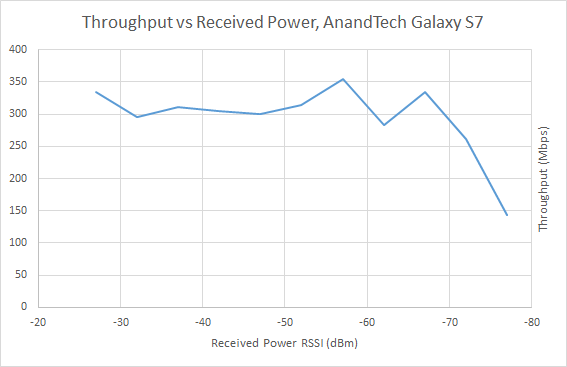The Samsung Galaxy S7 and S7 edge Review: Part 2
by Joshua Ho on July 5, 2016 8:00 AM ESTWiFi Testing with Ixia IoT
As previously discussed, RF testing has always been a major unknown to some extent because environmental factors make it extremely difficult to tell exactly what is going on with the system. I don’t think it really needs to be said but previous reviews and any controversy regarding the quality of RF has always lead to a ring of confusion and back and forth with no clear-cut answers, at least in the public domain. The Transformer Prime and Pixel C reception issues have all been cases where I’ve seen a lot of confusion over whether a problem really existed in the hardware, software, or with the end user.
Most people really don’t have any understanding of how wireless transmission works, probably because it’s not really something you can see. As far as I know, no one is capable of seeing radio waves, even at high frequencies like 60 GHz. Of course, the problem is that for quite some time our testing was also not really ideal for seeing the quality of an RF implementation. While iPerf does provide some useful data, free space testing means that we’re dealing with channel conditions that inherently cannot be controlled. As a result, the only sensible test we could do with iPerf was focus on maximum throughput in the best conditions we could provide. The only thing that this can highlight is the upper bound of efficiency for WiFi due to the carrier sense multiple access scheme in most cases, and rarely detects a whole class of problems that affect user experience on WiFi.
In order to test these things we’ve moved to using a proper testing system that is actually used by at least a few OEMs today, namely Ixia IoT. While we discussed the possibilities for testing, at this time due to the RF isolation chamber used we are limited to AP simulation only, so we can’t properly simulate clients in the channel without restricting ourselves to a single spatial stream for both the AP and client. This wouldn’t be a very useful test if set up in this manner as most devices today that we’re testing have support for two spatial streams, and many routers have three or even four spatial streams at this point.
The first set of results we can talk about that will be of interest is rate vs range. This is a fairly simple test at a conceptual level, as it simply tries to see how well a device can maintain its performance in the face of reducing signal to noise ratio for a given modulation and coding scheme. This is a good high level test of how well a device can maintain a connection as reception degrades. In this test the HTC 10 had an initial RSSI of -28 dBm while the GS7 was at -21 dBm and the iPhone 6s at -22 dBm, which allows us to calculate the path loss and determine the RSSI as a function of the transmit power.
The results of this test are interesting to say the least. Off the bat, every device had different RSSIs measured, so this meant that everything had different levels of path loss. The HTC 10 seemed to have the most path loss, while the Galaxy S7 and iPhone 6s were functionally identical. However it looks like RSSI is really an insufficient metric here because while the iPhone 6s was able to reach maximum throughput using NSS 2 MCS 8, the HTC 10 and Galaxy S7 did its best at NSS 2 MCS 4 or 5. I suspect this may be just due to placement as device positioning strongly affects MIMO as receive-side spatial correlation reduces the gains that MIMO can provide. Regardless, the HTC 10 somehow manages to beat the Galaxy S7 through much of the curve, but for some reason suffers from a reduction in throughput at higher transmit power. It's worth mentioning though that this test doesn't allow for testing of antenna gain or similar tests. Given various levels of futzing about with the device positioning in the test chamber I'm fairly confident that the Galaxy S7 is consistently better with regard to path loss, so even if it doesn't perform as well at a given RSSI it tends to have a higher RSSI than the HTC 10 by about 5 dBm which is fairly significant.
Finally, the other test that we can run at this time is the roaming latency test, which tests how well a device can hop from one access point to another as the received transmit power rises and falls. If you ever rely on WiFi to work as you walk around any building larger than a single apartment unit, you’re going to feel the effects of high roaming latency as VOIP calls or any real-time network application will either experience interruption or drop altogether if roaming is not implemented properly.

In the case of the Galaxy S7, roaming latency is honestly rather wanting. In the best case the Galaxy S7's roaming latency appears to be acceptable, but it's still significantly worse than the best we've seen so far. It seems that Samsung's algorithms have issues with edge cases as I've seen multiple instances so far where the device just can't handle roaming consistently. Despite consistent positioning and identical test setup I've seen cases where the Galaxy S7 has problems with consistent roaming. Even with the simple case of 10 dBm to -45 dBm at 3 dBm drop per second, I've encountered weirdness where the device drops from the network altogether claiming that the password given was incorrect (it wasn't) or a few successful handovers followed by getting stuck on a single access point or dropping from the network entirely. Even in the best set of trials performed I still saw 3 of 64 trials fail to roam correctly. The performance is certainly far better than something like the Google Pixel C, but Samsung should really be focusing on improving here.













266 Comments
View All Comments
retrospooty - Wednesday, July 6, 2016 - link
Close... I wish Anandtech would get back to the "tech" part. It used to be about tech and now as you even agree, its about clicks and paying the bills.BurntMyBacon - Wednesday, July 6, 2016 - link
@dsumanik: "heres proof:http://www.ibtimes.com/apples-ios-still-getting-cr...
I kinda see what you're getting at here, but these numbers are from October of last year. Though, I couldn't help but note that according to these numbers, Windows is actually persisting in most markets. The numbers aren't great, but enough to be a significant presence. Even the U.S. is 3.5%. I thought we were seeing articles around this time period about how the Windows market share was sub-1%, insignificant, and dead to rights. Question is, are we sure these numbers are accurate? Or is it that tech review websites are preaching Windows doom and gloom to generate clicks? I suppose the second option would fit the mold that M2K is suggesting.
Byte - Tuesday, July 5, 2016 - link
Apple rules the mobile roost right now. Just look at the sales, app ecosystem, users. Why aren't you crying that Apple has all of that? Don't even get started at tablets, there isn't even any contest. One day though, maybe soon, it will come crashing down, just like what happened to Blackberry, what will you cry about then?Geranium - Wednesday, July 6, 2016 - link
Apple's CPU performs better running Apple optimized benchmark.jlabelle2 - Wednesday, July 6, 2016 - link
- There is something wrong with you if you think of people as with you and against you -I think it is pretty clear that the editorial line has changed since departure of Anand (...to Apple "cough").
For instance, when speaking of the camera, there is a mention that the resolution of the 12Mp S7 is not better than the 12Mp iPhone 6S (strange?) but when speaking of low light, as the iPhone is not anymore a contender (as the images show), then we mode the reference to LG or HTC. And this is constant all around Apple products review just to make the Apple shine when they should and when they are not, just move the discussion elsewhere.
I mean, qualifying the S7 design of average? Really?
- Look at the CPU performance and you see that the 820 and Exynos both struggle to hit the top of the charts. -
This is the ONLY area where iPhone are constantly shining. The iPhone 6 CPU was the best thing after slice bread here on this site: "the A8 SoC performs admirably ... It remains to be seen if other SoC manufacturers will catch up in their CPU architecture at one point or another, but for now Apple seems to be quite far in the lead in CPU performance".
But now that the S7 is having the same performance, you have: "the Galaxy S7 in its Snapdragon 820 variants performs pretty much as you'd expect with fairly respectable performance about on par with the iPhone 6 at least part of the time, which frankly still isn't enough ..." and "I have to install either a variant of Snapdragon Browser or Samsung's stock browser in order to get remotely acceptable performance".
So the performance is not enough and not remotely acceptable when it is not an iPhone?
And then come the GPU where it is very competitive and of course... the iPhone is nowhere to be seen.
Honestly, those kind of reviews are a reference for journalist school as the bias is becoming quite too much.
KoolAidMan1 - Saturday, July 9, 2016 - link
"There is something wrong with you"retrospooty and his brand obsessiveness in a nutshell
pablo906 - Friday, July 8, 2016 - link
Have you thought that maybe it's because Apple is doing amazing things with their hardware currently. They have the highest performing underlying storage of any phone by a wide margin, they have the fastest mobile SoC's out right now, and they have a very tidy app ecosystem with a very cohesive GUI that receives focused improvements in usability and performance. The other phone makers are measured in many categories against the bar that Apple sets. That's just a fact at this point. It's also impossible to discuss smart phones today without talking about iPhone vs. Android as that is literally the competition in the space today. iPhone vs Android.MonkeyPaw - Tuesday, July 5, 2016 - link
The iPhone 5s came out almost 3 years ago. I think we can move on.The Garden Variety - Tuesday, July 5, 2016 - link
Nope, some people apparently cannot. For retrospooty and a huge number of other regular visitors to Anandtech, ferreting out their bias boogeymen are an all-consuming passion. They honestly believe it's a "justice" issue—right and wrong, good and bad. It's instills the same feeling in them that religion or politics does in others.Maslow's Hierarchy of Needs at work.
retrospooty - Tuesday, July 5, 2016 - link
No, its not justice, its like i said in another comment below "That is OK, it's not like there aren't other Apple-centric sites out there and it is perfectly within the sites rights to run things the way they want to... But if you are looking for unbiased reviews on any products that compete with Apple, this site is no longer one of them, so browse accordingly." - It's just sad that this once well respected tech site is no longer trustworthy. I kid you not, Anandtech was my homepage, my first stop every time I launched my browser from 1998 to 2014. That is how often I was here. Now it is just another page in my feedly feed. Still pop in now and then to see whats up, and still sad to see the site has lost it's heart.